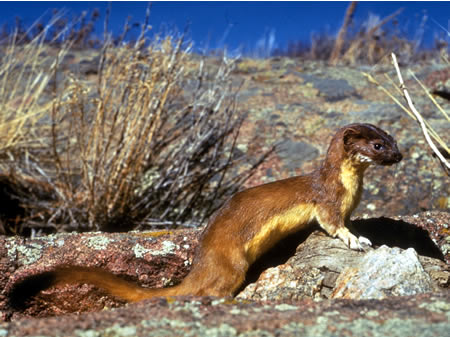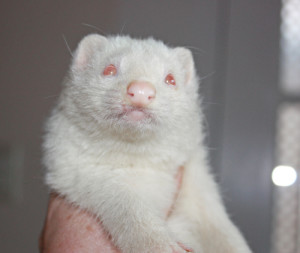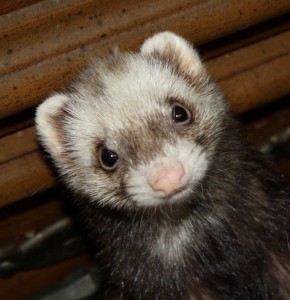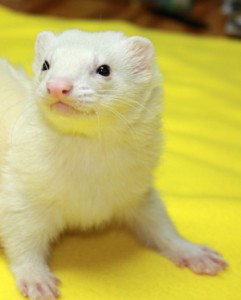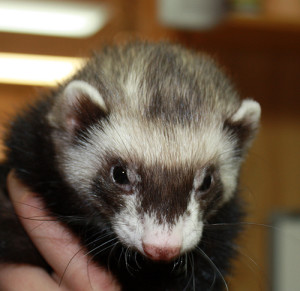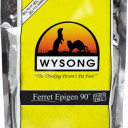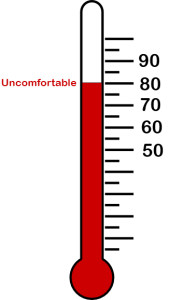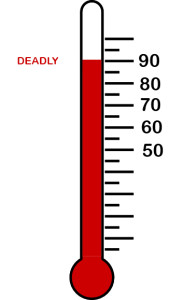We are getting another ferret in that was found in Upper St. Clair. We got one in a couple weeks ago that was found in Carmichaels. If you think one of these might be your ferret, please send us email.
Author: Barb Carlson
Is that a ferret you found?

Short-tailed weasel. This image was donated to the Creative Commons, courtesy of Wikipedia and the original image owner. Click on photo to go to the webpage.
A happy ending that might not have happened
How would you prove your ferret is yours? Ferrets get out–it happens to the best of us. If you are human, or have humans living in your home, chances are at some point your ferret is going to get out. Whether your ferret gets all the way out into the big, scary world, or just out into some area they aren’t supposed to be, depends on the layout of your home and how paranoid you are.
I wrote a (rather large) pamphlet on how to ferret proof your home (Ferret Proofing Your Home) but that’s not what this article is about. This article is about how to prove that the ferret someone found in their yard is actually your ferret. And to tell you about a happy ending.
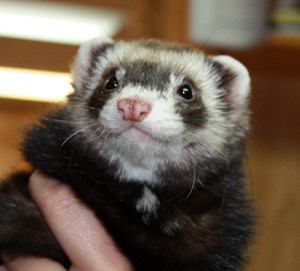 This is Phineas. He escaped his family’s house. Luckily, he went right over to a neighbor’s house and managed not to get run over. The lady who found him got the shelter number from someone and called me. I posted an ad on Craig’s List and someone wrote that it was their ferret and gave a rather vague description. If I had been less diligent, Phineas may have ended up in the wrong house. I don’t know if that person was looking for a free ferret, or if they really did lose a ferret in the same general area around the same time that Phineas got out.
This is Phineas. He escaped his family’s house. Luckily, he went right over to a neighbor’s house and managed not to get run over. The lady who found him got the shelter number from someone and called me. I posted an ad on Craig’s List and someone wrote that it was their ferret and gave a rather vague description. If I had been less diligent, Phineas may have ended up in the wrong house. I don’t know if that person was looking for a free ferret, or if they really did lose a ferret in the same general area around the same time that Phineas got out.
The problem with identifying Phineas is that he is a pretty standard sable ferret. You can’t say, “it’s mostly dark brown with some lighter color” to make a positive ID. Now, if the person had been looking for a white ferret, then there would not have been a problem. But they said a female and described a sable. Hmm. Lots of people don’t know the correct sex of their ferrets. I’ve even seen vet records with the wrong sex written down. So I asked for a little more information. They sent a photo of a girl holding three ferrets. One sable, one all-white and one a light chocolate. I had no way to know that the ferrets in the photo were even her ferrets. (It’s easy to find photos on the Internet.) At this point, I asked what street she lived on and she stopped writing.
That was rather scary. I might have accidentally given him to the wrong person. So that led me to the question, “How do you ID your ferret?”
Photos help, of course, but way too many photos show a ferret-sized blob in the middle of the room. They are dark, fuzzy, and way too far away to be useful. If your ferret has some special markings, getting a photo with the markings would help. But often, people photograph their ferret when it’s a baby and two years later it gets out of the house. Coloration and markings change. So then what?
Look at this ferret’s nose. Enlarge the photo if you have to. I’ll wait. Done? What do you notice about the ferret’s nose. Well, besides that it’s cute. What color is the nose? What color are the markings? What pattern do the markings make? The “nose print” stays the same all through a ferret’s life. Even when they are old and gray, the nose will stay the same. So get a clear, close-up photo of your ferret’s face. Look at his neck–do you see the white splotch? That’s another identifying feature. That might go away in time, though. Phineas has another not-very-visible identifying mark–he has a white splotch between the toes of his front feet. Good luck photographing that, but if you write it down, it will help.
Get a photo of your ferret (again, up-close and clear) of the top of his head and from the side. The shape of the ears and position in relation to the eyes does not change. The size of the eyes do not change (unless the ferret has glaucoma or a tumor, but that’s another story). Get a photo of the whole body from the side and top. Put the photos somewhere safe that a computer crash or dead cell phone will not erase. Photograph your ferret regularly. Enlist the help of someone with a good camera if you need to. (I have a good camera and I’m willing to help.)
But the very best way to prove your ferret belongs to you and get him back home is to have him microchipped. Ferrets are adventurous and want to see what is on the other side of that door. They will try and try and try to escape. You need to be sure you can get it back again. What would stop a neighbor from taking in your ferret and refusing to give it back? Legally, how could you prove that is your ferret? The microchip is the ideal way to prove the ferret belongs to you.
It’s a big needle, the ferret doesn’t like it (they do *not* need to be sedated) but it’s over in a second and that’s that. All chip readers can tell there is a chip in there. If you get an “open” chip that does not use a proprietary code, many readers can read them. I use the 24HrPetWatch chips, but I’ve used others. The key is to register the ferret, keep the records with his photo, and put it somewhere you can find it when you’re in a panic.
So go forth and photograph! Write down a description. Get your ferret microchipped. And give them a hug from me. I hope I never have to pick them up from a neighbor’s house!
Food again — sigh
Update: Check out the food chart at More Dooks: Food Chart
It has been brought to my attention that some of the foods we recommended to replace EVO have also had recalls. To say we’re frustrated is an understatement. So, sadly we have to rescind the recommendation for Blue Buffalo Wilderness and Wellness CORE foods. That doesn’t leave a whole lot, but here is what we recommend to feed your kibble-fed ferrets:
.
.
.
.
.
.
.
.
We will add more if we can find them. Another good food that some ferrets won’t eat (it is freeze-dried raw that should be re-hydrated before feeding):
For now, please avoid Zupreem Grain-Free. It has peas as the third ingredient (too high on the list) and has been linked to a flurry of ferrets getting bladder stones (from the plant protein). We want to avoid plant protein if at all possible. In kibble, it’s really hard. More and more we are convinced we should be feeding raw/whole prey to our ferrets.
If you have a new baby ferret, now is the time to start them on raw. Please contact Holistic Ferrets on Facebook or at their main discussion group on the Holistic Ferret Forum for help. Feeding raw, you need to feed a proper balance of meat, fat and bone for the ferret to get proper nutrition. All meat and no raw bone (raw bone is safe, cooked bone is not) will quickly make your ferret sick. I believe both Holistic forums require you to apply for membership and be serious about your intentions. These people are very experienced, though, and have helped a number of people to switch to raw (even ferrets who have been fed kibble up until now). Babies are the easiest. They eat anything.
Heat can kill ferrets
Ferrets cannot sweat, so a fan is NOT going to help unless the ferret is wet.
.
.
.
.
.
Erika Matulich, PhD says:
Temperatures above 80 degrees Fahrenheit are uncomfortable for ferrets, temperatures above 85 can cause medical problems within hours, and temperatures above 90 can be fatal. Although ferrets can live through high temperatures, heat-related stress weakens their immune system and shortens their life. If the outdoor climate has temperatures above 80 degrees, ferrets should be kept indoors in a temperature-controlled environment.
These temperature guidelines assume low humidity levels (less than 40 percent). If you live in a humid climate, look at the heat index (a combination of temperature and relative humidity) rather than the actual temperature. If the thermometer reads 82 degrees F and the relative humidity is 80 percent, the heat index is 90, meaning that it feels to us like 90 degrees F. This is because higher humidity levels don’t allow for moisture evaporation and heat dissipation from the skin. Although ferrets can’t sweat, they still need to lose heat from their footpads, nose, ears, and mouth; high humidity doesn’t allow for this. Because my ferrets and I live in South Florida, I pay special attention to humidity so that my fuzzies don’t have problems.
To avoid heat stress, keep your ferret in an air-conditioned room, away from direct sunlight. Provide adequate water, and use ice or evaporative cooling to cool the surrounding air. Despite taking these precautions, you may have a ferret suffer from heat stress, which can quickly lead to heatstroke. Heatstroke can be fatal within minutes—one of the reasons you should never leave your ferret (or any pet or animal) in a parked car.
See entire article: Heatstroke in Ferrets



